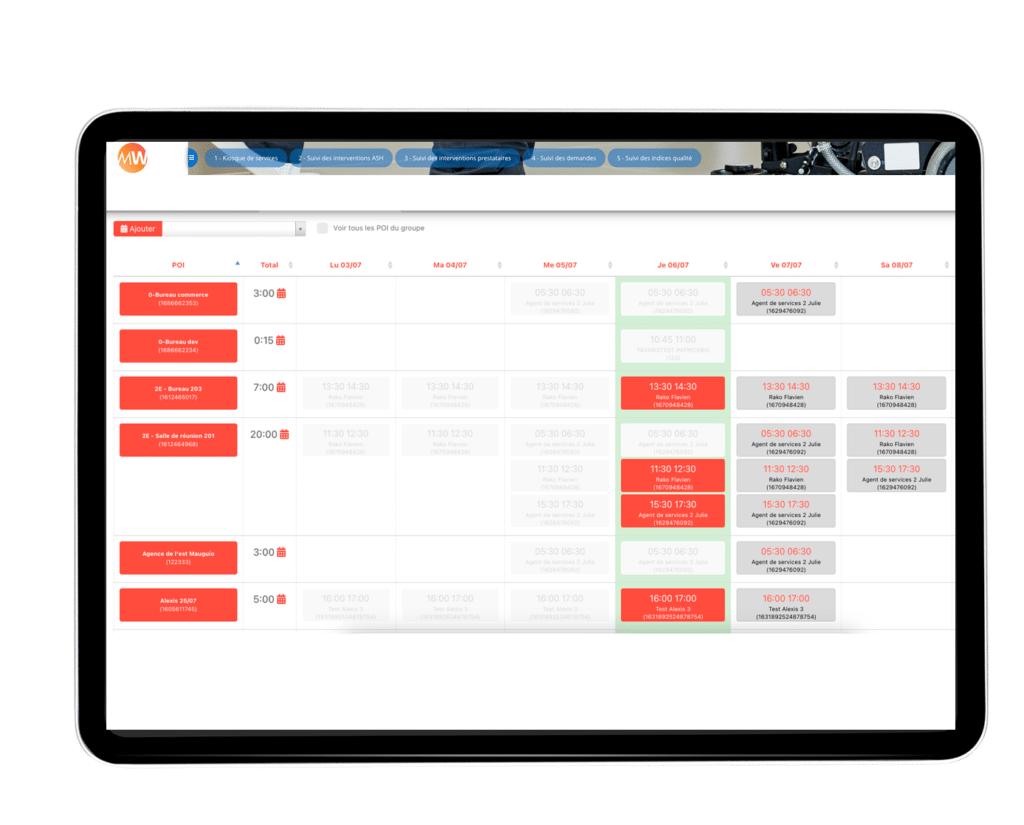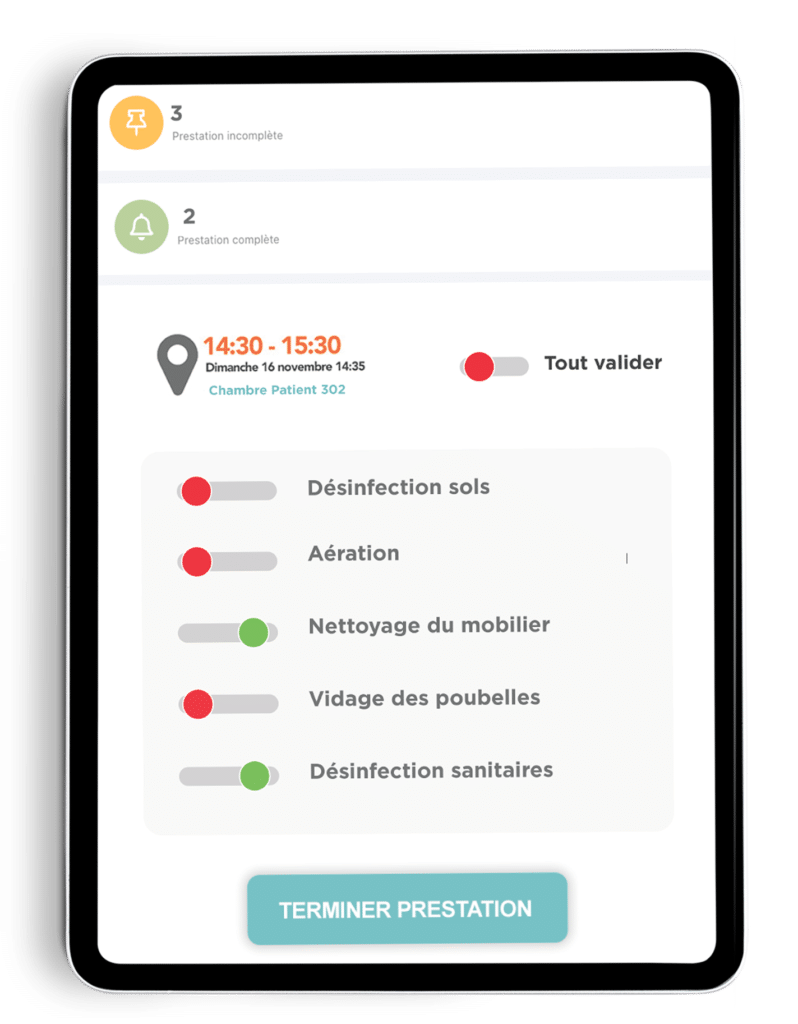In the medical sector, Hospital Service Agents (HAS) play a crucial role in the smooth functioning of healthcare facilities. Their work is often demanding and includes critical tasks such as cleaning rooms, disinfecting operating rooms, and maintaining common areas. Their missions contribute to the safety and well-being of patients by reducing the proliferation of bacteria.
However, scheduling management for HAS can quickly become complex for facility managers. This is where automation comes into play to simplify and enhance intervention management. Through automated systems, managers can now remotely and centrally record, adjust, and manage HAS schedules.

Why is it important to prepare the schedule of HAS ?
The schedule of HAS coordinates all activities related to the maintenance, environmental cleaning, and hygiene of medical facilities. Hospitalization team, discharge team, outpatient team… Each care service has specific intervention schedules. Between fixed positions, reference agents, floating teams, and substitutes, scheduling can become a real challenge.
The HAS schedule has several objectives:
- Plan and monitor the proper completion of cleaning and environmental tasks by agent, team, service, or building
- Ensure regular team visits to guarantee the cleanliness of the areas involved
- Allocate resources to intervention locations rationally to optimize the operational efficiency of hospital service agents
- Monitor the workload of each HAS and adjust tasks by adapting to constraints
- Ensure compliance with the implementation of health protocols
- Facilitate the management of biomedical waste
Therefore, creating well-thought-out schedules for HAS is an essential process. However, the more numerous the services and the more diverse the rounds, the more challenging the task becomes. The use of a paper document or a simple Excel spreadsheet quickly becomes insufficient.
The limitations of manual planning
Managing the schedules of HAS can prove to be a real challenge for healthcare facility managers. Indeed, organizing and managing schedules becomes particularly complicated when dealing with the schedules of a multitude of agents. Using a notebook or a traveling post-it note between services? Forget about these options!

The manual management of schedules represents a significant workload. Collecting data for each participant one by one can turn into hours of searching.
Who will be present for the night duty? Who replaces the HAS on leave? Who provides support after the transfer of an ultra-contagious patient? The situation can quickly turn into a nightmare, especially as numerous unforeseen events can occur at any moment.
HAS schedules require constant modifications. Manually adjusting the roadmaps is nearly impossible. Manual management can lead to confusion within teams, especially if information is not communicated clearly in case of changes. Moreover, in the absence of an HAS, manual replacement management is likely to result in errors with dramatic consequences. This work represents a considerable waste of time for the staff and can potentially jeopardize patient health.
What is the automation of HAS schedules ?
Before automation, the management of HAS schedules was predominantly done manually. Managers had to dedicate countless hours to creating, updating, and distributing work schedules. Additionally, handling replacements in case of absence, vacation requests, and last-minute adjustments was often a logistical puzzle.
The automation of HAS schedules involves using tools to computerize, digitize, manage, and optimize intervention planning. Work schedules and tasks assigned to HAS are digitized and accessible on digital devices for optimal productivity. Thanks to real-time data collection in the field, automation allows for timely adjustments to HAS schedules. An HAS is absent? They are immediately replaced! Tasks not completed? The nearest agent is automatically contacted to finish the cleaning protocol!

Therefore, the automation of HAS schedules ensures continuity of service in all circumstances. Patients and visitors are attended to at all hours for maximum satisfaction. Staff needs, skills, assignment preferences, and regulatory constraints are analyzed by advanced algorithms to create optimal schedules.
In conclusion, the automation of HAS schedules also allows for tracking and generating reliable and accurate KPI reports: working hours, attendance rates, non-compliance, inventory management, operating costs…
What are the advantages of automating HAS schedules?
Automating HAS schedules not only enhances operational efficiency but also reduces costs associated with human resources management. It also contributes to ensuring better service quality in healthcare facilities by providing adequate coverage at all times. With schedule automation, healthcare establishments experience numerous benefits:
Reduction of planning and reporting errors
Errors in hospital service schedules are common when managed manually. Automation of HAS intervention scheduling addresses this issue by generating reliable automatic schedules. There’s no longer a need to inquire about an agent’s days of presence or ask a doctor if they have ordered a patient’s discharge; everything is digitized.
Operational data is collected using digital devices to obtain real-time information. This also simplifies the management of leaves and last-minute adjustments. The working conditions of healthcare providers and hospital service agents are thereby improved.
Increased adaptability of HAS schedules
In a healthcare facility, unforeseen events and last-minute changes are common occurrences. Schedule managers must always be available for any changes and able to inform their teams. This lack of visibility can lead to errors or confusion if information is not communicated correctly.
Automated systems simplify schedule management by enabling a quick response to requests or alerts. Absences, leaves, incidents, or replacements are reviewed in real-time, and schedules are adjusted accordingly.

Automated HAS schedules, a time-saving benefit
Another advantage of automated scheduling is the time-saving benefit for the entire staff. Firstly, managers will have the ability to handle organization and necessary changes directly on a single digital platform. They gain an overall view of their structure or healthcare service. Performance reports can also be generated by agent or team.
Furthermore, the automation of schedules will enable HAS to perform the right interventions at the right time. They no longer have to worry about possible scheduling errors or duplicate tasks. Automation allows them to save time in their daily tasks and focus on the main goal: ensuring the safety of patients.

MoveWORK Flow for enhanced automation of HAS schedules
MoveWORK Flow features a connected, ergonomic, and user-friendly scheduling module. With its system of workflows and automations, this tool becomes the ideal platform for integrating and automating the schedules of your HAS. MoveWORK Flow tackles unforeseen events by triggering automatic corrective action scenarios.
Through the platform, you can easily manage agent interventions by site, team, or intervention type. Combined with an IoT sensor ecosystem, you gain real-time visibility into your facility. Furthermore, MoveWORK Flow has unlimited storage space that archives all the flows of your structure.
What processes to automate in HAS schedules?
The schedule of an HAS is quite busy, as it must include several specific tasks. Among the automatable processes with MoveWORK Flow, we find:
- Replacement of an HAS in case of absence or delay
- Triggering of corrective actions in case of non-compliance
- Reassignment of tasks in case of incomplete or not performed protocols
- Sending intervention requests in case of incident or detected anomaly
- Sending intervention requests in case of a patient leaving a room
- Restocking consumables in case of low capacity level
- Placing orders for consumables in case of low stock
The possibilities for scenarios are nearly endless! Our experts study your intervention processes and infrastructure to create customized workflows according to your needs.
The advantages of the MoveWORK Flow platform
- The schedules are easily accessible in real-time on the platform or our dedicated mobile applications
- It is very easy to integrate a team’s schedule with IoT sensors or mobile clock-ins to validate the completion of an intervention
- Our platform allows the integration of your healthcare software into its interface: DX Care, Hospital Manager, Chronos, etc. MoveWORK Flow data feeds into your management systems, and vice versa.
- MoveWORK Flow makes it easy to analyze your team’s performances, pinpoint areas for improvement, and optimize costs without compromising the quality of interventions

